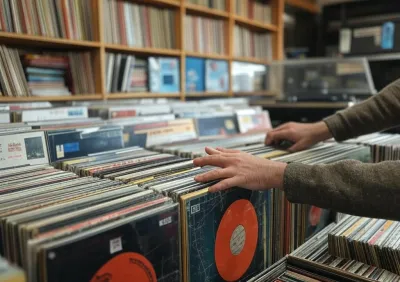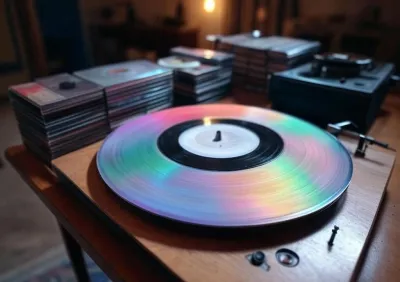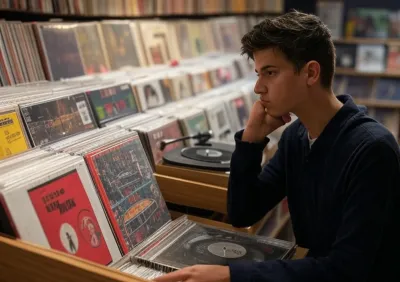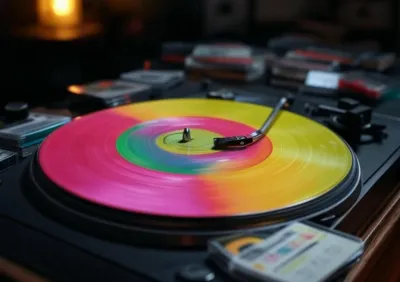In an era dominated by streaming and cloud-based convenience, a quiet revolution is spinning back into focus. By 2025, vinyl records, cassettes, and CDs—formats once relegated to the dustbin of obsolescence—are staging a remarkable comeback. Far from mere relics, these physical media have morphed into coveted collectors' items, nostalgic touchstones, and cultural statements for fans worldwide. What began as a niche revival in the 2010s has blossomed into a full-blown resurgence, defying predictions of a fully digital future. Why are these analog artifacts thriving in a world of playlists and algorithms? The answer lies in a potent mix of nostalgia, tactile allure, and a rebellion against the ephemeral nature of modern music consumption.
The Roots of the Revival
The resurgence of physical media didn’t happen overnight. Vinyl’s renaissance kicked off in the late 2000s, fueled by audiophiles and hipsters who prized its warm, rich sound over compressed MP3s. By 2015, sales were climbing steadily, with the Recording Industry Association of America (RIAA) reporting 17 million units sold in the U.S. alone—a figure that seemed quaint compared to streaming’s dominance. Yet the trend persisted. Fast-forward to 2025, and vinyl sales have soared past 50 million units annually, outpacing CDs for the third consecutive year. Cassettes, too, have clawed back, with 500,000 units sold in 2024, while CDs, though lagging, still move 20 million copies yearly.
This revival owes much to a cultural shift. As streaming platforms like Spotify and Apple Music swallowed the industry—accounting for 85% of music revenue by 2025—listeners began craving something tangible. Digital files, stored in invisible servers, lack the weight of ownership. Vinyl, with its hefty platters and gatefold sleeves, offers a ritual: dropping the needle, flipping the side. Cassettes evoke mixtape memories, their whirring tapes a lo-fi antidote to polished streams. Even CDs, once mocked as outdated, shine anew as affordable, durable keepsakes.
Retail reflects this hunger. Record Store Day, launched in 2007, has grown into a global phenomenon, with 2025’s event generating $100 million in sales across independent shops. Chains like Urban Outfitters and Target stock vinyl alongside clothing, while boutique labels press limited-run cassettes. “Physical media is a middle finger to the cloud,” says vinyl collector Jaden Ruiz. “It’s mine, not a rental.”
Nostalgia: The Soundtrack of Memory

Nostalgia is the emotional fuel of this resurgence. For Gen X and Millennials, vinyl and cassettes recall a pre-digital youth—spinning LPs at sleepovers or trading mixtapes in schoolyards. In 2025, a 40-year-old might buy Nirvana’s Nevermind on vinyl not just to hear it, but to relive 1991. Meanwhile, Gen Z—born into a world of downloads—embraces these formats as retro novelties, drawn by Instagram-worthy aesthetics and a yearning for what they never knew. A 2024 Pew survey found 68% of 18-24-year-olds owned at least one physical music item, with “nostalgia for a past I didn’t live” cited as a top reason.
Artists tap this vein masterfully. Taylor Swift’s 2025 re-release of Evermore on marbled vinyl sold 300,000 copies in a week, each disc a pastel artifact fans clutched like talismans. Billie Eilish’s Happier Than Ever cassette drop, complete with a Walkman bundle, sparked a TikTok frenzy, proving nostalgia sells even to the young. Labels lean in, too—Rough Trade’s 2025 cassette revival series, featuring indie acts like Wet Leg, moved 50,000 units, blending old tech with new sounds.
The sensory pull is key. Vinyl’s crackle, a cassette’s hiss, a CD’s booklet—these imperfections ground fans in a way streams can’t. “I don’t just hear the music,” says fan Maya Patel. “I feel the weight of it in my hands.” In a 2025 X thread, users swapped stories of unboxing limited editions, one calling it “Christmas morning every time.” Physical media isn’t just playback; it’s an experience.
Collectors’ Fever: Rarity and Ritual

Beyond nostalgia, collecting drives the boom. Vinyl, cassettes, and CDs have become fetish objects—artifacts with value beyond their sound. In 2025, a first-pressing Beatles White Album fetches $10,000 at auction, while a rare Wu-Tang Clan cassette from 1993 hits $5,000 on eBay. Even new releases turn into treasure hunts: Kendrick Lamar’s 2025 album Echo Chamber, pressed in a glow-in-the-dark run of 1,000, sold out in hours, with resales topping $500 each.
Limited editions fuel this frenzy. Labels like Third Man Records churn out colored vinyl—neon pink, splatter green—capped at tiny runs to stoke demand. Cassettes, cheap to produce, get the boutique treatment: hand-numbered tapes in custom cases, often bundled with zines or pins. CDs, less sexy but practical, see deluxe reissues with bonus tracks, luring completists. “It’s Pokémon cards for music nerds,” jokes collector Ethan Kim. “Gotta catch ‘em all.”
The ritual of collecting amplifies the appeal. Fans scour shops, trade online, and display their hauls on shelves or in glass cases. A 2025 Vinyl Me, Please survey found 73% of subscribers bought records they never play, valuing them as decor or status symbols. Social media amplifies this—X and Instagram teem with #VinylCollection posts, where pristine LPs gleam like trophies. “It’s not just music,” says Kim. “It’s a lifestyle.”
The market responds. Discogs, the collector’s hub, logged 15 million transactions in 2024, up 20% from 2022. Specialty presses like QRP in the U.S. and Optimal in Germany run at capacity, struggling to meet demand. Yet scarcity—real or manufactured—keeps prices climbing, with some fans griping on X about “scalper bots” snagging drops. “I’m priced out of my own hobby,” one lamented in 2025.
Sound Quality: Myth and Mastery
Sound quality is a rallying cry for the resurgence, though its role is debated. Vinyl enthusiasts swear by its analog warmth, claiming it captures nuances lost in digital compression. A 2025 audiophile forum on X boasted blind tests where LPs trounced MP3s, with users raving about “depth” and “presence.” Cassettes, too, have their defenders—lo-fi artists like Mac DeMarco praise their gritty charm, a rawness AI-generated streams can’t fake.
Science tempers the hype. Studies, including a 2024 Journal of Audio Engineering paper, show vinyl’s fidelity varies wildly—new pressings often use digital masters, negating any “pure” advantage. Cassettes degrade with each play, and CDs, while crisp, lack vinyl’s mystique. Still, perception trumps data. “It’s not about specs,” says sound engineer Priya Anand. “It’s about what you believe you’re hearing.”
For casual fans, sound is secondary. A 2025 RIAA poll found only 22% of vinyl buyers cited audio quality as their top reason—most chased nostalgia or aesthetics. Yet the myth persists, fueled by high-end turntables like Technics’ $4,000 SL-1000R, a 2025 bestseller. Physical media’s allure isn’t just sonic; it’s emotional.
Artists and Industry: Cashing In

Artists and labels have seized the resurgence as a lifeline. Streaming’s paltry payouts—$0.003 per play on Spotify—push musicians toward physical sales, where margins soar. A $30 vinyl LP nets an artist $10-$15 after costs, dwarfing digital pennies. In 2025, vinyl accounts for 12% of U.S. music revenue, up from 4% in 2020, per the RIAA. Cassettes and CDs, though smaller, add gravy—$5-$10 per unit.
Superstars lead the charge. Beyoncé’s 2025 Renaissance II vinyl, with a holographic cover, grossed $20 million in pre-orders. Indie acts like Phoebe Bridgers press short-run cassettes, turning modest releases into goldmines. “Physical is where I make my living,” Bridgers told Pitchfork in 2025. “Streams pay the rent; vinyl buys the house.”
Labels adapt, too. Majors like Universal and Warner invest in pressing plants, reversing decades of divestment. Indies like Merge Records thrive on exclusivity—their 2025 Best of Merge CD box set sold 10,000 units at $50 each. Yet supply lags: vinyl’s six-month lead times frustrate artists, and cassette tape shortages spark X rants about “Big Plastic” gouging prices.
Retail pivots hard. HMV in the UK doubles vinyl floor space by 2025, while U.S. indie stores report 30% revenue spikes. Even Amazon joins, its “Vinyl of the Month” club hitting 200,000 subscribers. “Physical isn’t dead,” says HMV’s CEO. “It’s our future.”
Cultural Pushback: Analog vs. Digital

The resurgence isn’t just commerce—it’s a cultural stand. In 2025, streaming dominates with 1.5 trillion annual plays, per IFPI, but its intangibility breeds discontent. “I don’t own my playlists,” one X user posted. “Spotify does.” Physical media offers control—a bulwark against algorithm-driven sameness. Fans on X rail against AI music’s rise, calling vinyl “humanity’s last stand.”
This pushback spans generations. Boomers dust off turntables, Millennials hoard CDs from their teens, and Gen Z adopts cassettes as irony-turned-sincerity. Subcultures amplify it—punk bands press 7-inches, hip-hop revives mixtape swaps. A 2025 Bandcamp study found 60% of its sales were physical, bucking digital trends.
Yet it’s not all rosy. Critics call the resurgence elitist—vinyl’s $30 price tags exclude casual fans, and collectors’ snobbery alienates newcomers. “It’s a rich kid’s game now,” one X thread griped. Sustainability worries linger, too—vinyl’s PVC production emits carbon, clashing with eco-conscious 2025 vibes.
The Future: Spinning Forward
Where does physical media go from here? In 2025, vinyl’s growth slows but holds at 55 million U.S. units, per RIAA projections, with cassettes and CDs stabilizing as niche darlings. Analysts see a ceiling—streaming’s convenience won’t fade—but the resurgence proves durability. “Physical won’t die,” says Discogs founder Kevin Lewandowski. “It’s too human.”
Innovation hints at more. In 2025, Sony trials “smart vinyl” with embedded NFC chips linking to digital bonus tracks, bridging old and new. Cassette players get Bluetooth upgrades, and CD reissues pack VR liner notes. Collectors cheer, though purists scoff on X: “Leave my LPs alone!”
For fans, the why endures. Vinyl’s heft, a cassette’s hum, a CD’s gleam—they’re more than media; they’re memory, identity, rebellion. In a digital age of flux, physical music stands still, a nostalgic anchor in a streaming storm. As one X user put it in 2025: “I’ll take scratches over skips any day.”




Leave a Reply